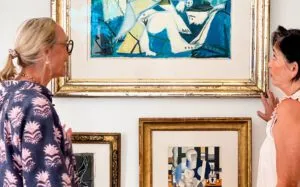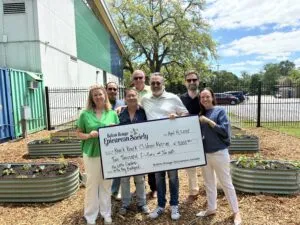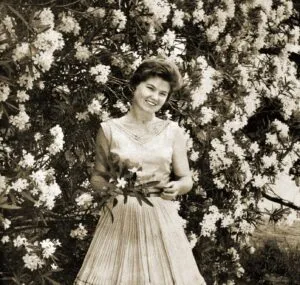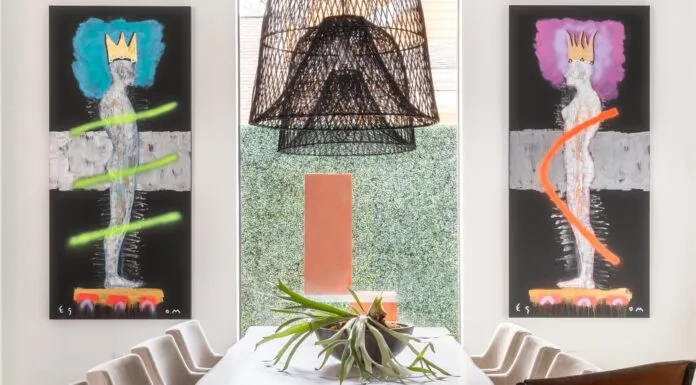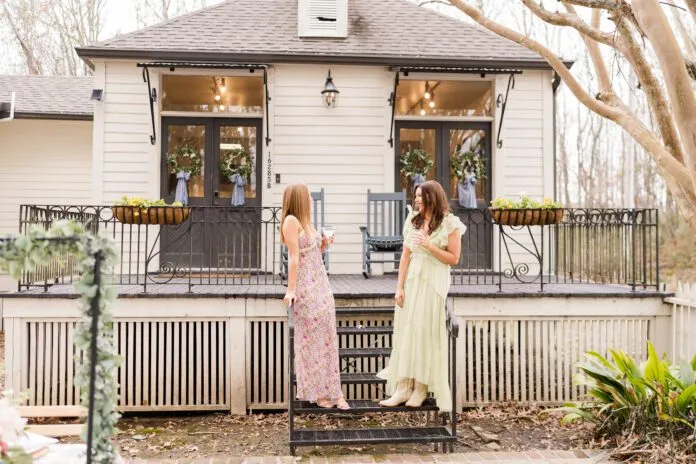
Nonprofit leaders reflect on how local organizations have changed and where they’re headed next
On the surface, their passions might sound very different: Autism. Animal welfare. Roadside litter. But the seven women inRegister recently assembled for a roundtable discussion actually have much in common. They all seek to better the Baton Rouge community, and they are working hard to realize their lofty visions.
In our anniversary-issue conversation aimed at capturing how the community’s philanthropic and nonprofit sectors have evolved over the years, these leaders laughed and even cried a little as they spoke of the challenges and high points they’ve experienced. On the following pages are highlights of our discussion.
Kelli: How would you say that philanthropy and the nonprofit sector in Baton Rouge have changed in recent years?
Norisha: I think that all industries were trying to figure out how to use technology to enhance their operations, but COVID forced people to move faster than they had initially anticipated. I also think that the evolving ways that people get their information have forced nonprofits to figure out different ways of connecting to donors. You’ve got to constantly be innovating, quicker than you ever had to in the past.
Jillian: Over the last 10 years or so, I think organizations have become more specialized in what they focus on. In the past, they might have focused on education or animals, and now it’s very specific topics within those categories, so they can really ensure that they’re doing a lot for one cause versus a little for a lot of things.
Kim: Baton Rouge is a community of caring, and I’m encouraged that we have a community that sees a need and—if there isn’t already a solution—comes together to create an organization to meet that need. I actually think that COVID slowed us down as a community and made us focus on our families and friends and what their needs were. I think it caused many more people to want to give back to our community.
Sylvia: What I’ve noticed is that there are a lot more nonprofits that have come into being. At Channel 2, I probably get about three or four emails from nonprofits every week, and they’re looking for a way to get their story out there. The exposure is important for them. There seems to be such a saturation now, and it’s kind of repeating a lot of the same things, so I think that’s why it’s important to be more specialized in what you want to focus on.
Jennifer: When I started picking up trash during the height of COVID, I had no dream of being a nonprofit. I didn’t imagine that so many people would want to help. From there it led to this huge movement, and it shocked all of us because the more we did it, the more people who wanted to join. It’s been a real God thing. He led the way. It’s been so beautiful to see the community coming together to help us.
Shelton: Obviously, COVID is like the big watershed moment for many of us in the nonprofit community. But I was really inspired by campaigns like 225 Gives where businesses and foundations decided to help these organizations. It came at a point where I’m sure all of us were just trying to work our way through a whole new reality, and it was really a confidence booster to know that those groups were behind us. It was also a time that we tried a lot of new things. You just have to be creative and innovative.
Christina: I’ve been so inspired by the partnerships with other nonprofits. We’ve made inroads with other groups that are doing things that we know will benefit the children and families we serve. Rising tides float all boats, and so it really is important to work together.
Kelli: What would you all say is one of the biggest challenges that local charitable organizations are facing right now, and is that different than in the past?
Jillian: I think it’s dollars, it’s money. We’re expected to do so much more now, yet funding has never been so restricted. I think donors and granters are more aware, but they want their dollars to be very targeted, so they’re funding programs but they’re not really funding operational costs anymore like salaries and overhead. Programs are important, but they aren’t possible if you can’t afford to pay the people who are running them, so it’s been a really big struggle for us to find those essentially unrestricted dollars.
Jennifer: For our group, no one makes a salary, so all the money that we get goes right back into the community. We have a van and truck that were donated, and we have to maintain those, but insurance is eating our lunch right now. They consider it a commercial endeavor, even though it’s a nonprofit, so the insurance is so expensive. It’s just a really big issue.
Kim: I feel like keeping up with the times has been a struggle. When COVID happened, our gala, which is our major fundraising event, didn’t happen that year, so we had to go virtual. It was really hard to go through that. Another example is social media. We are also 100% volunteers—no one gets paid—but trying to do TikTok is really a challenge. However, I know that our youth are on TikTok and it’s a good way to reach them.
Shelton: One of our biggest focus areas is identifying new donors, but younger donors. I definitely get a sense that there’s this generational shift in our community where we’ve had these tremendously generous families and individuals, and now our job is to kind of identify and inspire that next generation, because these issues that we’re all working on are not going to go away. I think there are many individuals in our community who value the organizations we serve, and it’s our job to really educate them and say, “If you want these types of organizations to make Baton Rouge better, help us out.”
Norisha: When you’re in such a big industry like Our Lady of the Lake is with healthcare, there are so many things you could talk about, whether it’s helping children or heart health or cancer, but you have to talk about it in a way that’s not technical but that resonates with people. It’s getting people to understand what the philanthropic dollars are covering and how they make a difference. It’s a lot to try to fight through and communicate when there are so many messages that are out there.
Christina: Trying to communicate your value is definitely a challenge. It’s sort of a squishy story for an organization like a children’s museum. You can’t always document the specific outcomes, so it’s a lot of anecdotal storytelling. We’re trying to figure out ways to communicate the emotions related to those stories because they are important. It’s not just the numbers. We know we have an impact on the community. A lot of funders want those outcome statistics, and we struggle to provide those, but we know that every day we see those smiling faces and parents who say their visits have changed their lives as a family.
Jennifer: My group does daily cleanups, and we document every single thing and post it on social media, so the public sees everything that we do. We never ask for a donation, but people see what we’re doing and then ask how they can donate.
Sylvia: The challenge that I’ve had is smaller nonprofits asking to do collaborations with me, and I’m trying to meet the needs of those organizations that want toys. It kind of becomes a situation where I feel like my organization has become the donor in a sense, trying to help these smaller groups. And in order for me to be able to do that, I have to find people willing to provide the funds to buy more toys. I don’t want to say no to any organization that asks for help, but I’m finding myself in a position where I just don’t have the toys to donate to everybody who asks unless I have more donors. So where I had not been asking for money and had just been asking for toys, I’m having to shift to also asking for monetary donations.
Kelli: Let’s talk about fundraising events. I know Baton Rouge is a town where people like to go to a big party, and annual fundraising galas have been the bread and butter of a lot of our nonprofits. But has that changed over the years? And for those of you who do have an annual event, has the way you put on that event evolved to try to capture more involvement and more donors?
Shelton: COVID made us all kind of just take a huge pause and think about why we were hosting these events. Obviously, there is the revenue that you would like to generate. Obviously, there’s a huge marketing and communications benefit. But we started looking at our annual fundraiser and asking, “How do we grow our donor pipeline through that event?” What that has meant for us is a strategic pivot. What does the designing of that event look like if you have a new donor walk in, learn about our mission, and make a gift? And for us, the hard work starts right after the event, when we follow up with all those donors, thanking them and inviting them in to tour. Because ultimately what you want to do is convert what I would call the event giver to someone who really is a consistent donor. That’s tricky, because this community is very driven by events.
Norisha: There’s also always a pressure for the fundraisers: How do we make this year’s event bigger and better than last year, but cheaper than last year? It’s a tough cycle to be in.
Kim: This year, we actually started a brand new event, a tennis tournament, and it sold out very quickly. For our main event, Bella’s Ball, the challenge that I have found over the years is finding a venue that’s big enough and has all the resources to support the event. We’ve had such a great response and people want to come, but it’s hard to find the space.
Kelli: What are some of the new ways that your organizations are connecting with donors that you might not have been pursuing five or 10 years ago?
Norisha: Because healthcare is a complicated issue to discuss, Our Lady of the Lake Foundation has started having quarterly events called C3 conversations. We invite our donors to hear from hospital staff members who have brought in new technology or are engaging in new research or new practices. There are breakthroughs that are happening right here in our community, so we want our donors to learn about them and become excited about them and be able to communicate that information to others.
Sylvia: I’m blessed to have WBRZ as a media sponsor for Sylvia’s Toys for Christmas, and in addition to TV I am able to promote our program on all of its social media platforms. Also, last year, the most amazing thing happened: I got a call from a group that wanted to do a donation drive for us, and so I talked about it on TV, and it just blew up. All of these other organizations began approaching me to say they would also have donation drives for us, and they were talking about it on their social media. It was great to see how quickly the word got out and how quickly it spread.
Jillian: There’s no one-size-fits-all approach anymore. Different generations and different people want to be engaged and to donate in very different ways. So the way we try to build a relationship with a Gen Z donor is definitely going to be different than with a baby boomer. We have to do different campaigns and different strategies for different groups. It’s all about figuring out how to make sure you are spreading your message.
Shelton: We started texting our donors for specific campaigns in the last few years. We found that a lot of people were opting out of our emails, so we needed to find them in other ways. And we have gotten a tremendous response to the texts. But what has never changed for us is that fundraising is about relationship building, and that is a peer-to-peer model—asking our volunteers and our board members to introduce us to individuals in the community who might share a passion for our mission. That is a bedrock of what we do, and all of these other tactics are layered on that.
Norisha: To get the really large dollars that really move the needle in a nonprofit, it is about building relationships that occur over a significant period of time, and then making sure that you identify something with your organization that resonates with someone who’s a major donor and prompts them to make a commitment that lasts multiple years.
Sylvia: You’re talking about telling stories, and I think that’s the best way to communicate to potential donors, even on social media. I’ve started interviewing some of the children on distribution day, if their parents are OK with it, and having them talk about what it means to receive a toy. They tell the story better than I could tell it, because they are the ones who are absolutely impacted by it. So I think testimonials from people who explain the impact it has had on their lives are huge, and can really tug at those heartstrings.
Jillian: Having an organization and its board and volunteers be representative of the community is extremely important. Animal welfare is a very uniting topic—most people love animals. But if the organization only looks a certain way, you’re only going to connect with people who look like you. But having it be reflective of the community is going to help to secure the donations that might have been ignored previously.
Kim: I handwrite every thank-you card, and I really try to make sure that the people who are giving know how important their gift is and where it’s going.
Kelli: How do each of you measure the impact that your nonprofit is having on the community?
Jennifer: Our corridors are looking great, and people are wanting to help. It’s been amazing to watch the community coming together. And I can’t even tell you how exciting it is to see our city being transformed. But the thing I’m most proud of, even more than the number of bags we’ve filled and routes cleaned up, is when I can take somebody on the street who is homeless or addicted to drugs and help them. That is my greatest accomplishment.
Kim: We have a research study with LSU and we get to meet with them on a regular basis to hear how they’re trying to create safer treatments for people who are battling cancer. It’s just so hard to say what the measure is—it’s every time I get a message from a family who received a comfort care bag when their child is in the hospital, or when a clinician tells me about a patient who wanted to wear the T-shirt we gave her at her funeral. It just fuels our team.
Sylvia: I could give you the numbers, but I think just hearing people share their story of how it’s blessed them speaks even more loudly than the numbers. That means the world.
Christina: I cannot share all of the stories—we would be here forever. But whether it’s the Head Start teacher whose class got to come to the museum, or the family of a special needs child who came during special hours and played together, or the reduced-price tickets we offer through the Museums for All program … Once they come into the building, you have no idea who is there under what program, and everyone is playing together, and it is the most diverse, inclusive place you will find in the city at any given time. And it just gives me joy to watch it.
Shelton: We’re very fortunate that families will share their journey at Emerge, but because we are a medical clinic and we are a school, we do thankfully have measures and outcomes as well. We were able to serve this many children this year compared to last year. We’re also trying to increase the number of autism evaluations that we can give to families because we know that when children receive our therapies at an early age, they can really have great success. And with our charter school, where our model is to give children the therapies and support they need to find success in less restrictive educational environments, we have 48 students at our school and 14 transitioned out and were ready to move on to a different school last year. So what I have always found is that you have to combine the storytelling with the data.
Christina: One thing that has been very helpful for us is allowing the people and groups that we have forged partnerships with to help tell the stories about why they value what we’re doing. It really helps to have those people amplify our story and us amplify their story. And so those partnerships have been great.
Jillian: Companion Animal Alliance is the only open intake animal shelter for East Baton Rouge Parish, which means we are legally not allowed to turn any animal away. In the summers, I get up to 50 animals a day. How the community really measures our success is our save rate, and we work every single day to save as many lives as possible, but that is only one piece of what we do. I also measure our success in the number of animals we’re vaccinating for free that aren’t dying or spreading disease throughout our community, the number of animals that we spay and neuter for free that are not contributing to overpopulation, the number of animals who we temporarily house when their owners are unhoused. When they can’t afford veterinary care, we’re providing that for them at no cost. We have a saying: A lack of resources doesn’t mean a lack of love.
Norisha: When you are wondering why something is not happening with a particular organization, either you don’t understand everything that happens within that organization or you don’t understand the political infrastructure that is deeply rooted in this community that prevents a lot of that from happening. We don’t get to serve everyone that we need to serve. It makes it tough for people who have big hearts to try to do whatever they can, which often results in nonprofits having mission creep, because it’s hard to turn someone away. We are a warm state, but we don’t always offer our deepest empathy to people whose situation is not like ours and who are significantly struggling.
Kelli: What is one of your biggest hopes for our community?
Jennifer: My hope is to have tens of thousands of litter warriors all over the state of Louisiana picking up litter. And my hope is to have a cultural change in people’s attitudes toward litter. I want to get into the schools and start teaching young children so they can teach their parents not to litter.
Christina: My hope is that all of the generosity that this community exhibits continues to expand to meet the tremendous needs that exist here, because they’re always changing and they’re not going to go away. Whatever government is not able to do, nonprofits fill that gap, and if there’s not the support for those nonprofits, then we can’t do the work that we’re all doing that is so critically important to our community.
Kim: My hope for Baton Rouge is that we’re always striving for better. Our community is filled with unlimited potential, and our only limitations are ourselves. And for my organization, my hope is that no child battling cancer or medically fragile child and their family takes that journey alone.
Shelton: I feel like every child should have access to an excellent education, and I think improving our public school system is one of the most pressing priorities of our generation. Obviously, education is the foundation for everything, and I’m hopeful about the potential for some change in our community.
Norisha: I’m with you—our children deserve to have quality public education, and I think the reason I remain involved in the nonprofit sector even in my volunteer life is that I’m an eternal optimist, so I have a lot of hope for our public education system.
Sylvia: I hope that children will understand that they are loved and special and important, and that people who they may never know care enough about them to contribute in some manner to showing them love. Beyond just receiving a toy, I hope it reminds them that they are seen and cared for, and then that grows into a bigger understanding of their purpose and their significance in this world, and that they grow up and want to give back as well.
Jillian: I hope there’s a lot more collaboration among organizations. Bringing two missions together as one can be really powerful. I would also love nonprofit organizations to be treated like the powerhouse businesses that they are. These leaders could leave this field and probably make a lot more money with a lot less stress, but they are choosing to do this impactful work for our community.
Christina: I absolutely believe that a lot of volunteers could run Fortune 500 companies. And I think as a culture sometimes we undervalue that capacity to care. But without that work, our society would not survive. It’s the loving, showing the children love and improving education and helping animals and cleaning up our community. Those all impact our future—our collective future.
 Norisha: Women get things done, and a challenge I think we have right now in our community is that it’s the same women who are doing everything. I want other women to discover that you don’t have to be a CEO or an executive director to have a servant’s heart and make an impact in an organization in some way. Sometimes it’s about finding what that right opportunity is, and I hope that more women will step up and find their purpose in the community, because it’s really needed.
Norisha: Women get things done, and a challenge I think we have right now in our community is that it’s the same women who are doing everything. I want other women to discover that you don’t have to be a CEO or an executive director to have a servant’s heart and make an impact in an organization in some way. Sometimes it’s about finding what that right opportunity is, and I hope that more women will step up and find their purpose in the community, because it’s really needed.
Shelton: I hope this will inspire more women to get involved, because it’s deeply, deeply rewarding. We’re so passionate about our missions that it’s infectious.
Norisha: And that’s what Junior League of Baton Rouge does as well—we develop the potential of women by exposing our members to volunteer opportunities so they can find what their place is in the community. I just think the impact that organization has had over the past 92 years is just incredible. Junior League used the funds they raised from selling River Road Recipes cookbooks to start two organizations: the Baton Rouge Speech and Hearing Foundation, which is now Emerge, and the Louisiana Art & Science Museum. And what I learned is that when they created those two organizations and they wrote the structures for them, they made sure that Junior League would have members represented on their boards. And those were the first two boards in our community to have women on them. So because of that, we all can now serve in these roles.
Christina: Knock Knock would not be in existence if it was not for the founding women who did not accept “No” from anybody. There were a lot of challenges, but they made it happen.
Jennifer: The thing I’ve realized in doing what I do is that all of the stuff I thought was important really is not what truly matters. The important thing is giving back, and that’s something any woman or any person can do. Every woman at this table is a healer to problems in the world that are going to go by unnoticed unless we bring them to light.
Shelton: One of my other hopes is that we all continue to mentor each other. Just being here and hearing all your experiences—we all want to have a positive impact, and I just hope that there are more opportunities for these kinds of conversations. We’ve talked a lot about collaboration, and I don’t think we’re in competition. Sometimes you feel like you’re just toiling away day after day, and knowing that there is a tribe of women here to help you is so valuable. And we have to understand that we have to pay it forward a little bit to the next generation.










